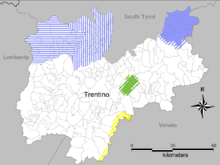- Mócheno language
-
Mócheno Spoken in  Italy, Fersina Valley
Italy, Fersina ValleyNative speakers 2,200 (date missing) Language family Language codes ISO 639-3 mhn Mócheno is an Upper German variety spoken in three towns of the Mocheni Valley (German: Fersental, Italian: Valle del Fersina, Mócheno: Bersntol), in Trentino, northeastern Italy.
Mócheno is closely related to Bavarian and is variously classified either as a Southern Bavarian dialect or a separate language of its own. Mócheno speakers reportedly partially understand Bavarian, Cimbrian, or Standard German. However, many essential differences in grammar, vocabulary, and pronunciation render it difficult for speakers of standard German to understand.
Contents
Geographic distribution
According to the census of 2001, the first in which data on native languages were recorded, Mócheno was spoken by a majority in the following municipalities (numbers of members of the Mócheno linguistic group): Fierozzo/Florutz/Vlarotz (423 people, 95,92%), Palù/Palai/Palae (184 people, 95,34%), Frassilongo/Gereut/Garait (340 people, 95,24% - including the village of Roveda/Eichleit/Oachlait). In other municipalities of Trentino 1,329 persons declared themselves members of the Mócheno linguistic group, a total of 2,276 in Trentino.[1]
Status
Mócheno is officially recognised in Trentino by provincial and national law. Starting in the 1990s, various laws and regulations have been passed by the Italian parliament and provincial assembly, that put the Mócheno language and culture under protection. A cultural institute was founded by decree, whose purpose is to safeguard and educate on the language. School curricula were adapted in order to teach in Mócheno, and street signs are being changed to be bilingual.
Example
Mócheno German English Vatar ingar
en Himbl,
gahailegt kimmp der Núm.
Der da Raich schellt kemmen.[2]Vater unser
im Himmel,
geheiligt werde Dein Name.
Dein Reich komme.Our Father
in heaven,
hallowed be your name.
Your kingdom come,References
- ^ "Tav. I.5 - Appartenenza alla popolazione di lingua ladina, mochena e cimbra, per comune di area di residenza (Censimento 2001)" (in Italian). Annuario Statistico 2006. Autonomous Province of Trento. 2007. http://www.minoranzelinguistiche.provincia.tn.it/binary/pat_minoranze/minoranze/ladini_mocheni_cimbri_pop_2001_x_comune_e_residenza.1205943234.pdf. Retrieved 2011-05-12.
- ^ "Das Vaterunser auf Móchenisch (Fersentalerisch)" (in Mócheno). Frankfurter Allgemeine Zeitung. 2006. http://commons.wikimedia.org/wiki/File:Vaterunser_zimbrisch.JPG. Retrieved 2011-05-13.
Further reading
- Grammar
- Anthony Rowley: Liacht as de sproch. Grammatica della lingua mòchena / Grammatik des Deutsch-Fersentalerischen. Istituto Culturale Mòcheno-Cimbro / Kulturinstitut für das Fersental und Lusern / Kulturinstitut Bersntol-Lusérn, Palù del Fèrsina (Trento) 2003, ISBN 88-900656-1-3 (Digitalisat: PDF)
- Dictionary
- Anthony Rowley: Fersentaler Wörterbuch. Wörterverzeichnis der deutschen Sprachinselmundart des Fersentals in der Provinz Trient/Oberitalien. Buske, Hamburg 1989 (= Bayreuther Beiträge zur Sprachwissenschaft, Dialektologie, 2), ISBN 3-87118-593-0
- Secondary literature
- Federica Cognola: Costruzioni infinitivali e fenomeni di trasparenza nel dialetto della Valle del Fèrsina In: Quaderni patavini di linguistica 22 (2006), pg. 3-48
- Hans Mirtes: Das Ferstental und die Fersentaler. Zur Geographie, Geschichte und Volkskunde einer deutschen Sprachinsel im Trentino/Norditalien. Institute für Geographie, Regensburg 1996 (= Regensburger geographische Schriften, Heft 26)
- Giovanni Battista Pellegrini (ed.): La Valle del Fèrsina e le isole linguistiche di origine tedesca nel Trentino: Atti del convegno interdisciplinare, Sant'Orsola (Trento), 1 - 3 settembre 1978. Museo degli usi e costumi della gente trentina, S. Michele all'Adige 1979
- Anthony Rowley: Fersental (Val Fèrsina bei Trient/Oberitalien) - Untersuchung einer Sprachinselmundart. Niemeryer, Tübingen 1986 (= Phonai. Lautbibliothek der deutschen Sprachen und Mundarten, Deutsche Reihe, Bd. 28; Monographien, Bd. 18), ISBN 3-484-23131-9
- Anthony Rowley: Die Mundarten des Fersentals. In: Maria Hornung (ed.), Die deutschen Sprachinseln in den Südalpen. Mundarten und Volkstum, Olms, Hildesheim / Zürich / New York, 1994 (= Studien zur Dialektologie, 3; Germanistische Linguistik, 124/125), pg. 145-160, ISBN 3-487-09957-8
- Anthony Rowley: Die Sprachinseln der Fersentaler und Zimbern. In: Robert Hinderling / Ludwig M. Eichinger (ed.): Handbuch der mitteleuropäischen Sprachminderheiten, Narr, Tübingen 1996, pg. 263-285, ISBN 3-8233-5255-5
- Anthony Rowley: "Mocheno e Cimbro". Von Dialekt(en) zu Sprache(n)? In: Dieter Stellmacher (ed.), Dialektologie zwischen Tradition und Neuansätzen: Beiträge der Internationalen Dialektologentagung, Göttingen, 19. - 21. Oktober 1998, Steiner, Stuttgart 2000 (= Zeitschrift für Dialektologie und Linguistik, Beiheft 109), pg. 213-221, ISBN 3-515-07762-6
- Bernhard Wurzer: Die deutschen Sprachinseln in Oberitalien. 5. erw. Aufl., Athesia, Bozen 1983, ISBN 88-7014-269-8
External links
 Media related to Mócheno language at Wikimedia Commons
Media related to Mócheno language at Wikimedia CommonsModern Germanic languages and dialects North Germanic West ScandinavianEast ScandinavianWest Germanic Achterhooks • Drèents • East Frisian Low Saxon • Gronings • Low German • Plautdietsch • Sallaans • Stellingwarfs • Tweants • Veluws • WestphalianAlemán Coloniero • Alsatian • Austro-Bavarian • Main-Franconian • Cimbrian • Hutterite German • Mócheno • Swabian • Swiss German • WalserCategories:- Language articles with undated speaker data
- Austro-Bavarian language
- Upper German languages
- German dialects
- Languages of Trentino-Alto Adige/Südtirol
- Indo-European language stubs
Wikimedia Foundation. 2010.

